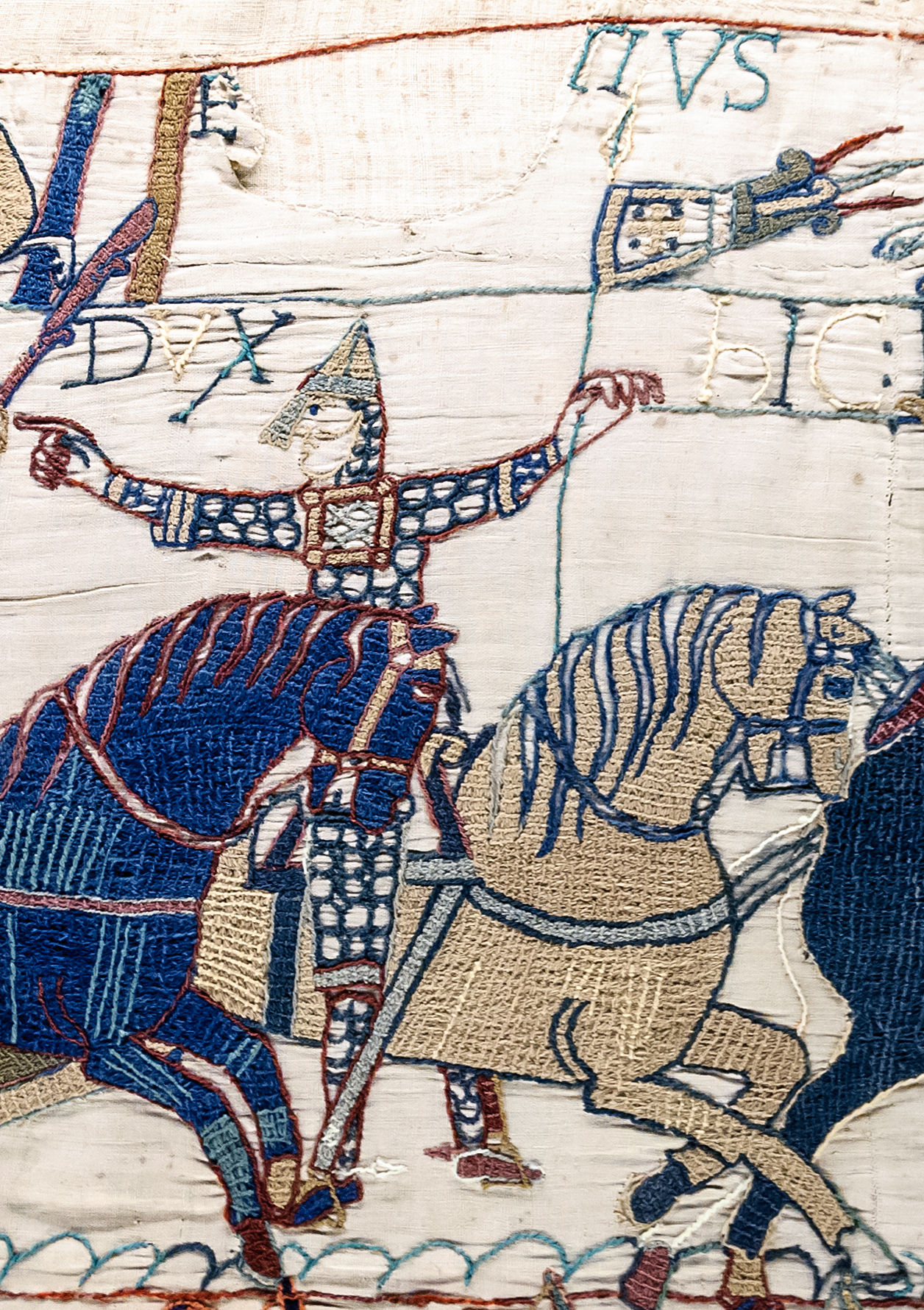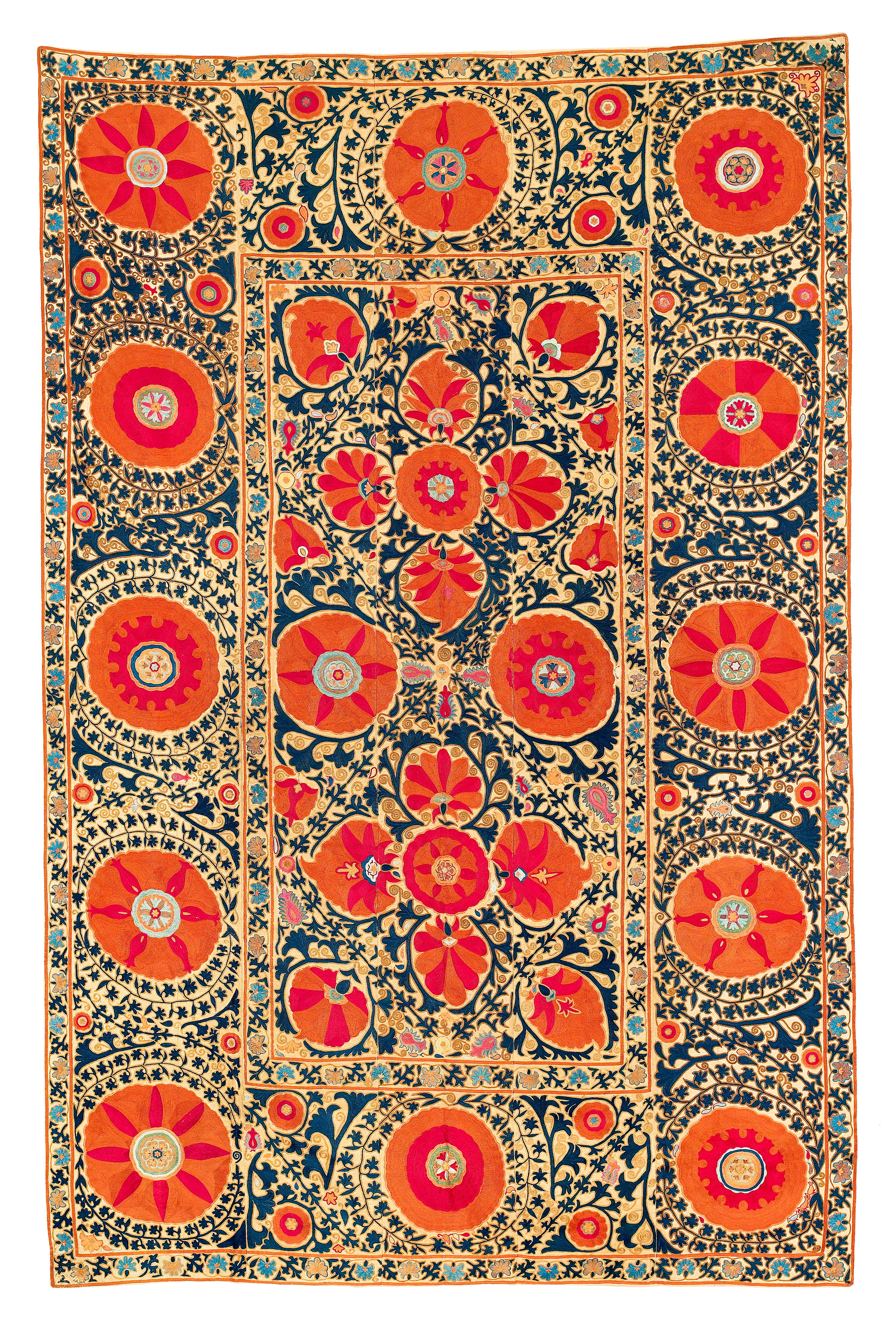|
Couching
In embroidery, couching and laid work are techniques in which yarn or other materials are laid across the surface of the ground fabric and fastened in place with small stitches of the same or a different yarn. The couching threads may be either the same color as the laid threads or a contrasting color. When couching threads contrast with laid threads, patterns may be worked in the couching stitches. Applications Laid work is one of two techniques used in the Bayeux Tapestry, an embroidered cloth probably dating to the later 1070s. (The other technique is stem stitch.) Underside couching of metal thread was characteristic of earlier Opus Anglicanum in Medieval England and was also used historically in Sicily and rarely in other parts of Italy and France. Couching is also characteristic of Japanese metal-thread embroidery and Central Asian suzani work. Another example of Islamic embroidery is the strong tradition of couching stitch in Palestine. Production centered on Beth ... [...More Info...] [...Related Items...] OR: [Wikipedia] [Google] [Baidu] |
Embroidery
Embroidery is the art of decorating Textile, fabric or other materials using a Sewing needle, needle to stitch Yarn, thread or yarn. It is one of the oldest forms of Textile arts, textile art, with origins dating back thousands of years across various cultures. Common Embroidery stitch, stitches found in early embroidery include the chain stitch, Buttonhole stitch, buttonhole or blanket stitch, running stitch, satin stitch, and cross stitch. Modern embroidery continutes to utilize traditional techniques, though many contemporary stitches are exclusive to machine embroidery. Embroidery is commonly used to embellish accessories and garments is usually seen on quilts, clothing, and accessories. In addition to thread, embroidery may incorporate materials such as Pearl, pearls, Bead, beads, Quill, quills, and Sequin, sequins to highlight texture and design. Today, embroidery serves both decorative and functional purposes and is utilized in fashion expression, cultural identity, and ... [...More Info...] [...Related Items...] OR: [Wikipedia] [Google] [Baidu] |
Beit Jalla
Beit Jala () is a Palestinian Christian town in the Bethlehem Governorate of Palestine, in the West Bank. Beit Jala is located 10 km south of Jerusalem, on the western side of the Hebron road, opposite Bethlehem, at altitude. In 2017, Beit Jala had 13,484 inhabitants according to the Palestinian Central Bureau of Statistics. About 80% of the population were Christians (mostly Greek Orthodox and Roman Catholic) and about 20% Muslims. Saint Nicholas – the inspiration for Santa Claus – is the patron saint of Beit Jala, where the Church of Saint Nicholas was built over a crypt where it is believed he lived for a couple years during his time in Palestine. Etymology Conder and Kitchener identified Beit Jala with ''Galem'' or ''Gallim'' (Γαλλιμ) of the Septuagint,Conder and Kitchener, 1881, SWP III, p20/ref> a place in the 9th district of the inheritance of Judah; homonymous with a settlement in Benjamin NE of Jerusalem. History Byzantine period A crypt, d ... [...More Info...] [...Related Items...] OR: [Wikipedia] [Google] [Baidu] |
Goldwork (embroidery)
Goldwork is the art of embroidery using metal threads. It is particularly prized for the way light plays on it. The term "goldwork" is used even when the threads are imitation gold, silver, or copper. The metal wires used to make the threads have never been entirely gold; they have always been gold-coated silver or cheaper metals, and even then the "gold" often contains a very low percent of real gold. Most metal threads are available in silver and sometimes copper as well as gold; some are available in colors as well. Goldwork is always surface embroidery and free embroidery. The vast majority is a form of laid work or couching; that is, the gold threads are held onto the surface of the fabric by a second thread, usually of fine silk. The ends of the thread, depending on type, are simply cut off, or are pulled through to the back of the embroidery and carefully secured with the couching thread. A tool called a ''mellore'' or a stilleto is used to help position the threads a ... [...More Info...] [...Related Items...] OR: [Wikipedia] [Google] [Baidu] |
Islamic Embroidery
Embroidery was Islamic art, an important art in the Islamic world from the beginning of Islam until the Industrial Revolution disrupted traditional ways of life. Overview Early Islam took over societies where the embroidery of clothes for both sexes and other textiles was very popular. Both the Byzantine and Persian Sasanian empires used clothing embroidered with designs including rather large human figures as well as animals, with effects comparable to those of modern teeshirts. The exterior of the Kaaba in Mecca was already before Islam "covered on the outside with multi-coloured textile hangings", very likely including embroidery as their modern Islamic equivalents often have. Muhammad objected to animal designs, perhaps embroidered, he saw on cushions when visiting his wife Aisha's house. These types of design largely disappeared under Islam, though plant-based motifs often remained acceptable. The 17th century Turkish people, Turkish traveller Evliya Çelebi called embro ... [...More Info...] [...Related Items...] OR: [Wikipedia] [Google] [Baidu] |
Japan
Japan is an island country in East Asia. Located in the Pacific Ocean off the northeast coast of the Asia, Asian mainland, it is bordered on the west by the Sea of Japan and extends from the Sea of Okhotsk in the north to the East China Sea in the south. The Japanese archipelago consists of four major islands—Hokkaido, Honshu, Shikoku, and Kyushu—and List of islands of Japan, thousands of smaller islands, covering . Japan has a population of over 123 million as of 2025, making it the List of countries and dependencies by population, eleventh-most populous country. The capital of Japan and List of cities in Japan, its largest city is Tokyo; the Greater Tokyo Area is the List of largest cities, largest metropolitan area in the world, with more than 37 million inhabitants as of 2024. Japan is divided into 47 Prefectures of Japan, administrative prefectures and List of regions of Japan, eight traditional regions. About three-quarters of Geography of Japan, the countr ... [...More Info...] [...Related Items...] OR: [Wikipedia] [Google] [Baidu] |
Beit Sahour
Beit Sahour or Beit Sahur (; Palestine grid 170/123) is a State of Palestine, Palestinian town east of Bethlehem, in the Bethlehem Governorate of the West Bank in the State of Palestine. The city is under the administration of the Palestinian National Authority. The population was of 13,281 in 2017, In the Village Statistics, 1945, 1945 statistics the population of Beit Sahour was 2,770; 370 Muslims and 2,400 Christians,Government of Palestine, Department of Statistics (1945), p24/ref> who owned 6,946 (rural) and 138 (urban) dunams of land, according to an official land and population survey. 1,031 dunams were plantations and irrigable land, 3,641 for cereals, while 100 dunams were built-up (urban) land. Jordanian annexation In the wake of the 1948 Arab–Israeli War and after the 1949 Armistice Agreements, Beit Sahur Jordanian annexation of the West Bank , was annexed by Jordan along with the rest of the West Bank. In 1961, the population of Beit Sahur was 5,316. Israeli occup ... [...More Info...] [...Related Items...] OR: [Wikipedia] [Google] [Baidu] |
Bethlehem
Bethlehem is a city in the West Bank, Palestine, located about south of Jerusalem, and the capital of the Bethlehem Governorate. It had a population of people, as of . The city's economy is strongly linked to Tourism in the State of Palestine, tourism, especially during the Christmas period, when Christians embark on a pilgrimage to the Church of the Nativity, which is revered as the location of the birth of Jesus. A possible first mention of Bethlehem is in the Amarna letters, Amarna correspondence of ancient Egypt, dated to 1350–1330 BCE, although that reading is uncertain. In the Hebrew Bible, the period of the Israelites is described; it identifies Bethlehem as the birthplace of David. In the New Testament, the city is identified as the birthplace of Jesus, Jesus of Nazareth. Under the Roman Empire, the city of Bethlehem was destroyed by Hadrian, but later rebuilt by Constantine the Great, who commissioned the Church of the Nativity in 327 CE. In 529, the Church of the ... [...More Info...] [...Related Items...] OR: [Wikipedia] [Google] [Baidu] |
Palestine (region)
The region of Palestine, also known as historic Palestine, is a geographical area in West Asia. It includes the modern states of Israel and Palestine, as well as parts of northwestern Jordan in some definitions. Other names for the region include Canaan, the Promised Land, the Land of Israel, or the Holy Land. The earliest written record Timeline of the name Palestine, referring to Palestine as a geographical region is in the ''Histories (Herodotus), Histories'' of Herodotus in the 5th century BCE, which calls the area ''Palaistine'', referring to the territory previously held by Philistia, a state that existed in that area from the 12th to the 7th century BCE. The Roman Empire conquered the region and in 6 CE established the province known as Judaea (Roman province), Judaea. In the aftermath of the Bar Kokhba revolt (132–136 CE), the province was renamed Syria Palaestina. In 390, during the Byzantine period, the region was split into the provinces of Palaestina Prima, Pal ... [...More Info...] [...Related Items...] OR: [Wikipedia] [Google] [Baidu] |
Suzani Rug
Suzani is a type of embroidered and decorative tribal textile made in Tajikistan, Uzbekistan, Afghanistan and other Central Asian countries. Suzani is from ( ). The art of making such textiles in Iran is called ''suzandozi'' "needlework". Suzanis are delicate; extremely few examples survive before the late 18th and early 19th centuries. However, they belong to a very ancient tradition. In the early 15th century, Ruy González de Clavijo, the Castilian ambassador to the court of Timur, left detailed descriptions of embroideries that were probably forerunners of the suzani. Suzanis were traditionally made by Central Asian brides as part of their dowry, and were presented to the groom on the wedding day. Types *Bukhara Suzani *Khujand Suzani (Khujand, Tajikistan) * Lakai Suzani * Nurata Suzani, made in the town of Nurata in Uzbekistan. *Piskent Suzani *Samarkand Suzani * Shakhrisabz Suzani *Tashkent Suzani * Ura Tube Suzani (Istaravshan, Tajikistan) *Isfara Suzani (Isfara ... [...More Info...] [...Related Items...] OR: [Wikipedia] [Google] [Baidu] |
Central Asia
Central Asia is a region of Asia consisting of Kazakhstan, Kyrgyzstan, Tajikistan, Turkmenistan, and Uzbekistan. The countries as a group are also colloquially referred to as the "-stans" as all have names ending with the Persian language, Persian suffix "-stan" (meaning ) in both respective native languages and most other languages. The region is bounded by the Caspian Sea to the southwest, European Russia to the northwest, China and Mongolia to the east, Afghanistan and Iran to the south, and Siberia to the north. Together, the five Central Asian countries have a total population of around million. In the pre-Islamic and early Islamic eras ( and earlier) Central Asia was inhabited predominantly by Iranian peoples, populated by Eastern Iranian-speaking Bactrians, Sogdians, Khwarezmian language, Chorasmians, and the semi-nomadic Scythians and Dahae. As the result of Turkic migration, Central Asia also became the homeland for the Kazakhs, Kyrgyzs, Volga Tatars, Tatars, Turkmens, ... [...More Info...] [...Related Items...] OR: [Wikipedia] [Google] [Baidu] |






